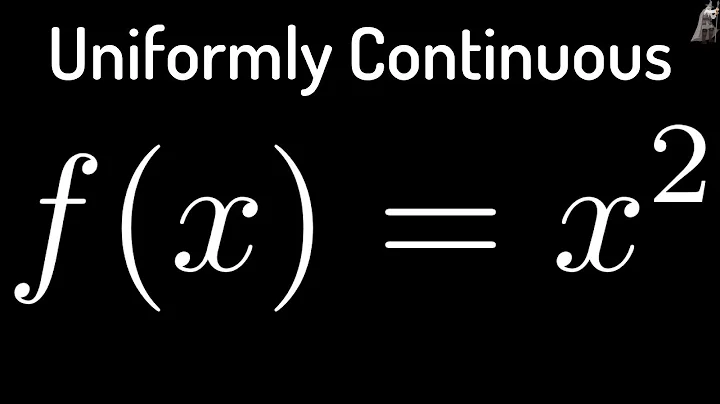Prove That a Continuous Periodic Function on R is Bounded and Uniformly Continuous on R
Prove a Continuous Distribution Function is Uniformly Continuous
Solution 1
Given a bounded monotone function $f:\mathbb{R}\to\mathbb{R}$, $\lim_{x\to-\infty} f(x)=a$ and $\lim_{x\to\infty} f(x)=b$ exists, by monotone convergence theorem.
Given a continuous function $f:\mathbb{R}\to\mathbb{R}$ s.t. $\lim_{x\to-\infty} f(x)=a$ and $\lim_{x\to\infty} f(x)=b$ exists, then $f$ is uniformly continuous.
Proof
$\forall\epsilon>0$:
$\qquad$ Let $e=\epsilon/3$.
$\qquad$ $\exists M_1\in\mathbb{R}^+$ s.t. $f((-\infty,-M_1))\subseteq(a-e,a+e)$.
$\qquad$ $\exists M_2\in\mathbb{R}^+$ s.t. $f((M_2,\infty))\subseteq(b-e,b+e)$.
$\qquad$ Let $M=\max(M_1+1,M_2+1)$.
$\qquad$ $f$ is continuous on $[-M,M]$, and so it is uniformly continuous.
$\qquad$ $\exists d>0$ s.t. $\forall x,y\in [-M,M], |x-y|<d\implies |f(x)-f(y)|<e$.
$\qquad$ $\forall x,y\in\mathbb{R}$:
$\qquad\qquad$ If $|x-y|<d$:
$\qquad\qquad\qquad$ If $x,y\in [-M,M]$, then $|f(x)-f(y)|<e$.
$\qquad\qquad\qquad$ If $x,y\in (-\infty,-M)$, then $|f(x)-f(y)|\le|f(x)-a|+|a-f(y)|<2e$.
$\qquad\qquad\qquad$ If $x\in (-\infty,-M),y\in [-M,M]$, then:
$\qquad\qquad\qquad\qquad$ $|f(x)-f(y)|\le|f(x)-a|+|a-f(M)|+|f(M)-f(y)|<3e$.
$\qquad\qquad\qquad$ All the cases are similar to the above, and so $|f(x)-f(y)|<3e\le\epsilon$.
Solution 2
$f$ is uniformly continuous on $\mathbb{R}\iff\forall\epsilon>0,\exists\delta>0$ s.t. $\forall x,y\in\mathbb{R},(|x-y|<\delta\implies|f(x)-f(y)|<\epsilon)$
If not, then:
$\qquad$ $\exists\epsilon>0$ s.t. $\forall\delta>0,\exists x,y\in\mathbb{R}$ s.t. $|x-y|<\delta$ and $|f(x)-f(y)|\ge\epsilon$.
$\qquad$ Substitute $\delta=1/n$ sequentially to obtain the sequences
$\qquad$ $(x_n),(y_n)$ which satisfy $|x_n-y_n|\to 0$ and $|f(x_n)-f(y_n)|\ge\epsilon$.
$\qquad$ If $(x_n)$ is not bounded above:
$\qquad\qquad$ Take a subsequence which $\to\infty$.
$\qquad\qquad$ The corresponding subsequence for $(y_n)$ also $\to\infty$.
$\qquad\qquad$ This contradicts the limit at infinity.
$\qquad$ So, $(x_n)$ is bounded above.
$\qquad$ Similarly, $(x_n)$ is bounded below.
$\qquad$ Take a convergent subsequence of $(x_n)$ which $\to t$.
$\qquad$ The corresponding subsequence for $(y_n)$ also $\to t$.
$\qquad$ This contradicts the continuity at $t$.
Related videos on Youtube
Comments
-
Let $F$ be the distribution function for a random variable $X$ and it is given that $F$ is continuous over the entire real line. Prove that $F$ is uniformly continuous over the real line.
My approach was something like this:
Take any two points $x$ and $y$ in $\mathbb R$. If $|x-y|>1$ then trivially $|F(x)-F(y)|\leq1<|x-y|$ hence $F$ is Lipschitz whenever $|x-y|>1$. So for all such points $x,y$ where $|x-y|>1$, $F$ is uniformly continuous.
However, I am stumped in the case where $|x-y|<1$. How do we finc a $\delta$ such that $|x-y|<\delta\implies|F(x)-F(y)|<\epsilon$, given any $\epsilon>0$?
Please give me some hint(s).
-
Can't we just use what you said earlier i.e. piecewise u.c. implies u.c.? Suppose I decompose $\mathbb R$ into lenghts of interval 1 each, then $F$ is u.c. on each such interval, then it is piecewise u.c. on all $\mathbb R$, so u.c. Won't this work?
-
@yedaynara No, there must be finitely many pieces for that one to work.
-
@yedaynara If not, any continuous function is uniformly continuous, but $\sin(x^2)$ is not.
-
Please explain the first sentence of ur answer. What do u mean by ends?
-
@yedaynara Alright. It's very precise now.
-
Please see my answer.
-
Please see the solution I have posted.
-
The second half of your solution does not seem to use the first half at all, and I gave you a counterexample earlier to the logic in the second half, which was $\sin(x^2)$. It is uniformly continuous in $[-L,L]$ for all $L\in\mathbb{R}$ but not uniformly continuous on $\mathbb{R}$. You must use the existence of the limits to $\infty$ and $-\infty$ in a non-trivial way.
-
But $sinx^2$ is not monotone increasing, whereas the distribution function is.
-
Actually I am still having difficulty processing the answer you gave i.e. how to get the $\delta$ and all that. I would be so grateful if you could give a complete solution, please.
-
Yes, but then what about $x^3$? You need to use both the monotone property and the fact that it is bounded, for it to imply that the limits to $\infty$ and $-\infty$ to exist, and then you need to use this fact to prove that it is uniformly continuous. I'll update my answer soon...
-
Yes, I was wrong about the "mixing" of the deltas. In fact the delta is the exact same one you get from the uniform continuity of the interval (which you must choose large enough).
Recents
What is the matrix and directed graph corresponding to the relation $\{(1, 1), (2, 2), (3, 3), (4, 4), (4, 3), (4, 1), (3, 2), (3, 1)\}$?
summerfieldhiseel.blogspot.com
Source: https://9to5science.com/prove-a-continuous-distribution-function-is-uniformly-continuous





0 Response to "Prove That a Continuous Periodic Function on R is Bounded and Uniformly Continuous on R"
Post a Comment